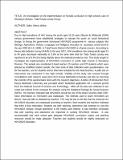An investigation on the implementation on HIV/AIDS curriculum in high schools:A case of wundanyi division Taita Taveta County- Kenya

View/
Date
2014-06Author
Salim, Mercy Wakio
Type
ThesisLanguage
enMetadata
Show full item recordAbstract
Due to high prevalence of HIV among the youth aged 15-24 years (Barnet & Whiteside
(2006) various governments have established strategies to educate the youth on social
behavioral change. In Kenya the government introduced HIV / AIDS programme in
various subjects like Biology, Agriculture, History, Languages and Religious education at
secondary school level in the year 2000 (K.I.E, 1999). In Taita/Taveta District HIV/AIDS
is of great concern. According to Kenya aids indicator survey (KAIS). In the year 2012,
HIV prevalence rate among adults aged 15 to 64 years decreased nationally to 5.6% at the
same time that for Taita Taveta County was reported to be at 6.4% this being slightly
above the national prevalence rate. This study sought to investigate the implementation of
HIVIAIDS curriculum in public high schools in Wundanyi Division. The sample size
constituted 6 head teachers 15 teachers and 470 students which were selected as stratified
random sample. The main tools of data collection were questionnaires, one for the
teachers, one for students and an interview schedule for the Head teachers. A pilot test on
instruments was conducted in two high schools. Validity of this study was ensured
through consultations with research supervisors from Kenya Methodist University and
also by marching the contents of the questionnaire items with the research objectives. A
letter of introduction from Kenya Methodist University was provided which facilitated
application for a research permit from the National Council of Science and Technology.
After all the data was collected it was coded and entered in the computer for analysis
using the Statistical Package for Social Sciences (SPSS). The teachers indicated that
HIV/AIDS should be one of the topics covered under CRE. Since information on
HIV/AIDS was inadequate. The methods used to teach HIV/AIDS are lecture, chat and
talk as indicated by teachers. This may be due to the fact that the resources for HIV / AIDS
education are inadequate according to teachers. Both students and teachers indicated
that there is low motivation. Students use peer teaching, abstinence and condoms to curb
the HIV / AIDS menace, though abstinence is the mostly used method. It was therefore
concluded that peer teaching and abstinence are important in curbing HIV/AIDS menace.
It was recommended that each school gets adequate HIV / AIDS curriculum copies and teaching resources should be made adequate. Teachers and students should be highly motivated on HIV / AIDS education.
Publisher
KeMU
Subject
HIV/AIDS curriculumDescription
RA 643 .S25 2014
